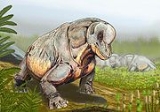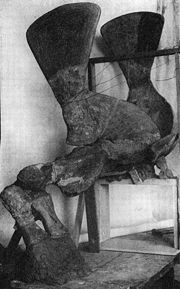
Tapinocephalus
Encyclopedia
Tapinocephalus is a genus
of large herbivorous
dinocephalia
n that lived during the Middle Permian
Period. These stocky, barrel-bodied animals were characterised by a massive bony skull roof and short weak snout. It is thought that, like the rest of the members of its family
, the animals engaged in head-butting intraspecific behavior, possibly for territory or mates.
 The fossil
The fossil
remains (skull
and postcranial elements
) of Tapinocephalus are known from the Lower, Middle, and Upper part of the Tapinocephalus Assemblage Zone
( Capitanian age
) of the Lower Beaufort Beds
of the South Africa
n Karoo
. Only the type species
, T. atherstonei is now considered valid for this genus.
In life, these animals were over 3 meters (10 ft) in length and weighed around 1.5 to 2 metric tonnes (1.6 to 2 short ton
s), making them among the largest animals of their time.
Keratocephalus
and Moschops
are closely related contemporary forms, of similar size and habits.
Genus
In biology, a genus is a low-level taxonomic rank used in the biological classification of living and fossil organisms, which is an example of definition by genus and differentia...
of large herbivorous
Herbivore
Herbivores are organisms that are anatomically and physiologically adapted to eat plant-based foods. Herbivory is a form of consumption in which an organism principally eats autotrophs such as plants, algae and photosynthesizing bacteria. More generally, organisms that feed on autotrophs in...
dinocephalia
Dinocephalia
Dinocephalia are a clade of large early therapsids that flourished during the Middle Permian, but became extinct leaving no descendants.-Description:...
n that lived during the Middle Permian
Permian
The PermianThe term "Permian" was introduced into geology in 1841 by Sir Sir R. I. Murchison, president of the Geological Society of London, who identified typical strata in extensive Russian explorations undertaken with Edouard de Verneuil; Murchison asserted in 1841 that he named his "Permian...
Period. These stocky, barrel-bodied animals were characterised by a massive bony skull roof and short weak snout. It is thought that, like the rest of the members of its family
Family (biology)
In biological classification, family is* a taxonomic rank. Other well-known ranks are life, domain, kingdom, phylum, class, order, genus, and species, with family fitting between order and genus. As for the other well-known ranks, there is the option of an immediately lower rank, indicated by the...
, the animals engaged in head-butting intraspecific behavior, possibly for territory or mates.

Fossil
Fossils are the preserved remains or traces of animals , plants, and other organisms from the remote past...
remains (skull
Skull
The skull is a bony structure in the head of many animals that supports the structures of the face and forms a cavity for the brain.The skull is composed of two parts: the cranium and the mandible. A skull without a mandible is only a cranium. Animals that have skulls are called craniates...
and postcranial elements
Postcrania
Postcrania[p] in zoology and vertebrate paleontology refers to all or part of the skeleton apart from the skull. Frequently, fossil remains, e.g...
) of Tapinocephalus are known from the Lower, Middle, and Upper part of the Tapinocephalus Assemblage Zone
Tapinocephalus Assemblage Zone
The Tapinocephalus Assemblage Zone is a geological stratum and is the thickest faunal zone of the Beaufort Group, in which has been found a rich variety of early therapsids. The name refers to Tapinocephalus, a genus of large herbivorous dinocephalian synapsids that lived during the Middle Permian...
( Capitanian age
Capitanian
In the geologic timescale, the Capitanian is an age or stage of the Permian. It is also the uppermost or latest of three subdivisions of the Guadalupian epoch or series. The Capitanian lasted between and...
) of the Lower Beaufort Beds
Beaufort Group
The Beaufort Group is the third of the main subdivisions of the Karoo Supergroup of geological strata in Southern Africa. It follows conformably after the Ecca Group and consists essentially of sandstones and shales, deposited in the Karoo Basin from the Middle Permian to the early part of the...
of the South Africa
South Africa
The Republic of South Africa is a country in southern Africa. Located at the southern tip of Africa, it is divided into nine provinces, with of coastline on the Atlantic and Indian oceans...
n Karoo
Karoo
The Karoo is a semi-desert region of South Africa. It has two main sub-regions - the Great Karoo in the north and the Little Karoo in the south. The 'High' Karoo is one of the distinct physiographic provinces of the larger South African Platform division.-Great Karoo:The Great Karoo has an area of...
. Only the type species
Type species
In biological nomenclature, a type species is both a concept and a practical system which is used in the classification and nomenclature of animals and plants. The value of a "type species" lies in the fact that it makes clear what is meant by a particular genus name. A type species is the species...
, T. atherstonei is now considered valid for this genus.
In life, these animals were over 3 meters (10 ft) in length and weighed around 1.5 to 2 metric tonnes (1.6 to 2 short ton
Short ton
The short ton is a unit of mass equal to . In the United States it is often called simply ton without distinguishing it from the metric ton or the long ton ; rather, the other two are specifically noted. There are, however, some U.S...
s), making them among the largest animals of their time.
Keratocephalus
Keratocephalus
Keratocephalus is an extinct genus of Tapinocephalia from the middle Permian of South Africa. Lower and Middle Tapinocephalus Zone, Karoo deposits, Lower Beaufort Beds; Beaufort West. It has a 2.5 to 3 m long ; 700 to 1000 kg; with a variable snout length; variable pachyostosis; nasofrontal...
and Moschops
Moschops
Moschops is an extinct genus of therapsid that lived in the Late Permian, around 255 million years ago. Therapsids were proto-mammals , which were the dominant land animals. Five metres long, Moschops was the largest land animal of its time, a herbivore preyed on by other therapsids...
are closely related contemporary forms, of similar size and habits.
External links
- Tapinocephalia - Tapinocephalus - Palaeos

